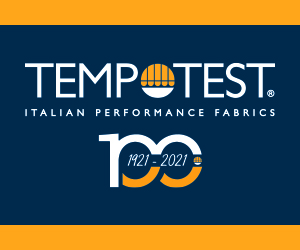Spanish Respond to Textile Flood with Brand Building, Added Value, Teamwork
December 12, 2005
BERLIN, Germany — Asian textiles have flooded markets everywhere, including Spain, a traditional textile stronghold and consumer of textiles.
According to Spanish government figures, Asian goods now make up 40% of textile imports to Spain. With the WTO removal of the remaining textile trade quotas in 2005, Spain has also witnessed a surge in textile imports from Pakistan, India and Turkey. India has reported a 41% increase of exports to Spain already this year.
"We are not able to compete in price with Asia and the strong euro continues to hurt our exports", said Rafael Revert, managing director of Textiles Intex, converter of low to mid range goods. "Our segment has been hit the most, but shipping defect-free goods with faster delivery times than China has kept us in business."
According to Revert, a few clients, attracted by cheap prices from China, made large orders and ended up with huge inventories that arrived with high defect rates. By staying closer to clients and building loyalty with a firm commitment to service, Spain's medium-sized firms like Intex say they have an advantage over Chinese firms. Revert said he has an ability to adjust quickly to the market, by introducing new designs more often and is offering smaller minimum orders.
For most companies, the best strategy has been to aim for the mid to mid-upper end priced fabrics. Over a decade ago, Spain's home textiles sector started making significant investments in equipment, product development and information technology for better distribution and marketing in anticipation of the devastating consequences that the new trade policies would have on the domestic industry. Cognizant of the importance of staying competitive, around 500 Spanish home textiles producers, in a joint effort with government organizations, associations, research institutes and universities, have built an infrastructure they hope will allow them to weather the Asian textile tsunami.
"We have invested heavily in technology, research in new products and training at all levels", said Ana Rios, export manager of Aznar Textil, producer of bedding and decorative fabrics. "We sell products with added value, not commodities. Our products reflect clear merchandising concepts which appeal to diverse consumer lifestyles." The collections are sold under their brand Bon Drap®. Branding is one of the most important business strategies that Spain's home textile industry has adopted to gain market share and win customer loyalty at home and abroad. Spain has a track record in establishing fashion brands in the apparel sector through companies like Zara, Camper and Mango.
In other branding examples, Interfabrics, a Spanish textile producer has introduced 'Destiny & Design,' a merchandising program with coordinated fabrics, accessories and decorative objects in free standing kiosks at specialty fabric stores in Europe and the United States.
Companies like Atrivm rely strongly on strategic alliances with well-known brands from other sectors. Atrivm has licensing agreements with Disney and Benetton for the distribution of bed linen and bath collections in Spain.
A growing interest in entering the home décor segment has led Spain's fashion designers like Adolfo Domingues, Agatha Ruiz de la Prada, Vittorio & Lucchino and Purificacion Garcia to team up with experienced manufacturers of bed and bath linen such as Atrivm, Manterol, Hierba Monesal and S.A. Sanpere to produce their collections and assist in the distribution process. Promoting Spain's home textiles sector through partnerships with top designers definitely helps to increase recognition for the "Made in Spain" label, reports Leticia Cano, spokesperson for Agatha Ruiz de la Prada. Top designers offer a strong sales network and their retail stores are usually located in the most successful fashion streets around the world, she said.
Branding products with added value, projecting today's consumer lifestyles, providing excellent service, short runs and collections with a clear Mediterranean flair is the future of Spain's home textile sector, said Miguel Bixquert, managing director of Textilhogar. This is Europe's oldest fair in the industry which will celebrate its 37th edition on Jan. 21 to 24, 2006. At Textilhogar, retailers and other visitors view the "Shopping Boulevard," a section with displays, merchandising concepts and the best brands to help them visualize how to dress their shops.
There is no doubt that Spain's home textile sector is being challenged. But with its well-equipped industry, unique and competitive products, and the teamwork at Home Textiles from Spain, Textilhogar and other organizations, it is making an all out effort to face the wave of Asian imports.
According to Spanish government figures, Asian goods now make up 40% of textile imports to Spain. With the WTO removal of the remaining textile trade quotas in 2005, Spain has also witnessed a surge in textile imports from Pakistan, India and Turkey. India has reported a 41% increase of exports to Spain already this year.
"We are not able to compete in price with Asia and the strong euro continues to hurt our exports", said Rafael Revert, managing director of Textiles Intex, converter of low to mid range goods. "Our segment has been hit the most, but shipping defect-free goods with faster delivery times than China has kept us in business."
According to Revert, a few clients, attracted by cheap prices from China, made large orders and ended up with huge inventories that arrived with high defect rates. By staying closer to clients and building loyalty with a firm commitment to service, Spain's medium-sized firms like Intex say they have an advantage over Chinese firms. Revert said he has an ability to adjust quickly to the market, by introducing new designs more often and is offering smaller minimum orders.
For most companies, the best strategy has been to aim for the mid to mid-upper end priced fabrics. Over a decade ago, Spain's home textiles sector started making significant investments in equipment, product development and information technology for better distribution and marketing in anticipation of the devastating consequences that the new trade policies would have on the domestic industry. Cognizant of the importance of staying competitive, around 500 Spanish home textiles producers, in a joint effort with government organizations, associations, research institutes and universities, have built an infrastructure they hope will allow them to weather the Asian textile tsunami.
"We have invested heavily in technology, research in new products and training at all levels", said Ana Rios, export manager of Aznar Textil, producer of bedding and decorative fabrics. "We sell products with added value, not commodities. Our products reflect clear merchandising concepts which appeal to diverse consumer lifestyles." The collections are sold under their brand Bon Drap®. Branding is one of the most important business strategies that Spain's home textile industry has adopted to gain market share and win customer loyalty at home and abroad. Spain has a track record in establishing fashion brands in the apparel sector through companies like Zara, Camper and Mango.
In other branding examples, Interfabrics, a Spanish textile producer has introduced 'Destiny & Design,' a merchandising program with coordinated fabrics, accessories and decorative objects in free standing kiosks at specialty fabric stores in Europe and the United States.
Companies like Atrivm rely strongly on strategic alliances with well-known brands from other sectors. Atrivm has licensing agreements with Disney and Benetton for the distribution of bed linen and bath collections in Spain.
A growing interest in entering the home décor segment has led Spain's fashion designers like Adolfo Domingues, Agatha Ruiz de la Prada, Vittorio & Lucchino and Purificacion Garcia to team up with experienced manufacturers of bed and bath linen such as Atrivm, Manterol, Hierba Monesal and S.A. Sanpere to produce their collections and assist in the distribution process. Promoting Spain's home textiles sector through partnerships with top designers definitely helps to increase recognition for the "Made in Spain" label, reports Leticia Cano, spokesperson for Agatha Ruiz de la Prada. Top designers offer a strong sales network and their retail stores are usually located in the most successful fashion streets around the world, she said.
Branding products with added value, projecting today's consumer lifestyles, providing excellent service, short runs and collections with a clear Mediterranean flair is the future of Spain's home textile sector, said Miguel Bixquert, managing director of Textilhogar. This is Europe's oldest fair in the industry which will celebrate its 37th edition on Jan. 21 to 24, 2006. At Textilhogar, retailers and other visitors view the "Shopping Boulevard," a section with displays, merchandising concepts and the best brands to help them visualize how to dress their shops.
There is no doubt that Spain's home textile sector is being challenged. But with its well-equipped industry, unique and competitive products, and the teamwork at Home Textiles from Spain, Textilhogar and other organizations, it is making an all out effort to face the wave of Asian imports.
















